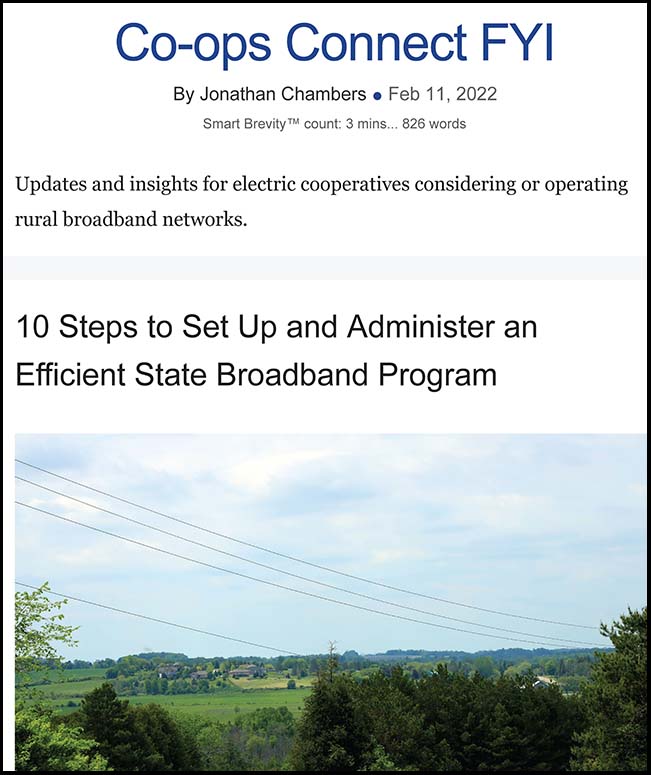10 Steps to Set Up and Administer an Efficient State Broadband Program
February 11, 2022
Remember last week’s takeaway:
To close the digital divide, Infrastructure Act funding requirements should address the answers to two key questions:
Updates and insights for electric cooperatives considering or operating rural broadband networks.
1. What level of internet access will exist in urban areas in a decade’s time?
2. What will be reasonably comparable to that service?
What's next:
- Unlike historical rural broadband programs, Infrastructure Act funding will be allocated to states to award.
- The amount of funding is greater than any prior state program; for some states the funding level will be an order of magnitude greater.
Preparation Matters
An efficient state broadband program starts with careful process planning.
1. Identify unserved and partially served census blocks in the state.
Use either FCC maps prepared pursuant to the DATA Act, or NTIA maps, state maps, or maps prepared by consultants not associatedwith any company or industry group.
2. Allocate funding by census block according to the Infrastructure Act formula or the projected cost to construct fiber networks.
- The Infrastructure Act will allocate funding to each state according to the percentage of unserved and high-cost areas in a state as compared to the country.
- A state could take the same approach at a local level, allocating funding according to the percentage of unserved and high-cost areas in a locality as compared to the state.
- Alternatively, utilize a cost model such as the Connect America Cost
- Model to determine the appropriate amount of funding by census block.
3. Set the required service for funding at the level of service reasonably comparable to service in urban areas in the state.
Remember last week’s lesson: The divide is widening because programs do not follow the dictates of the Universal Service provisions of the 1996 Telecommunications Act.
Applications Matter
Go deeper:
How state broadband offices approach applications is key.
4. Accept applications from companies that would build and operate networks in the eligible census blocks to provide the requisite minimum level of service for the allocated funding.
- The most successful funding programs use measurable criteria that narrow the decision to a few key elements.
- The overriding determination should focus on who is best suited to construct, operate, and maintain a network in the coming decades.
5. Vet applicants using objective criteria, including demonstrated capability to construct and operate the size and type of network and level of service proposed in the application.
Vetting could include proof of design maps, access to materials and labor, and participation in related federal programs, such as the Affordable Connectivity Program.
6. Approve applications for only a single year’s construction.
- Most state and federal broadband programs have been overwhelmed with funding requests.
- Structuring a program according to a yearly schedule forces applicants to apply only for what they can use in the coming year.
- This simplifies both application and oversight processes.
7. For census blocks covered by multiple applications, require applicants to submit a second, final application with a request for funding the overlapping census blocks. Then, award to the low-cost applicant.
As compared to 10-year programs such as RDOF or CAF, programs with yearly schedules are more manageable and adjustable.
Why it matters: An annual process will result in a more orderly, systematic build-out and will be easier to administer and monitor by small state broadband offices.
Verification Matters
Looking forward:
To ensure program success, end with project verification.
8. Reimburse projects upon completion and demonstration that every location has access to the requisite level of service.
It is far easier to audit completed construction than it is to administer an invoice reimbursement process.
9. In nine months, conduct the next round of funding applications.
- For applicants from the prior round, permit a follow-on application only if the applicant has substantially completed work from the prior round.
- The incentive for applicants should be to apply only for what they can complete.
- Why it matters: Funding won’t be tied up by companies who apply to block others from competing with them, as occurred in the RDOF auction.
10. After two rounds of funding, for any census block that has not received any applications, allow applicants to propose an amount of funding greater than the allocated amount. For census blocks with duplicative applications, award to the low-cost applicant.
While not every geographic area of a state may receive an initial application, within two years it will be clearer which areas may need more than the initial allocation.
Final Thought
There is enough funding in the Infrastructure Act to build a fiber network to reach every rural home.
The bottom line:
As a nation, we were able to construct electric networks with low-interest loans. We can certainly afford to build fiber networks with grants.
